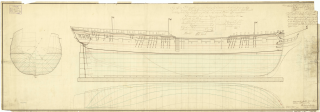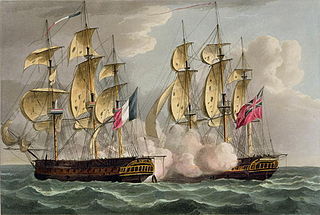Career
Patent first appeared in Lloyd's Register (LR) in 1803. [1]
| Year | Master | Owner | Trade | Source |
|---|
| 1803 | R.Barugh | Gillespie | Lynn | LR |
| 1804 | R.Barugh | Gillespie | Lynn
New Providence | LR |
|
On 29 December 1806 General Perpignon [sic] captured Patent, Barugh, master, at 49°48′N8°30′W / 49.800°N 8.500°W / 49.800; -8.500 as Patent was on her way from New Providence to London. However the gun-brig HMS Sharp Shooter and the hired armed cutter Britannia recaptured Patent and sent her into Plymouth. [2]
On 5 April 1808 Patent was among a handful of vessels in Margate Roads that lost their cables and anchors. Patent was on her way from Liverpool to London.
| Year | Master | Owner | Trade | Source |
|---|
| 1808 | R.Barugh
Anderson | Gillespie | London–New Providence
London–Jamaica | LR |
| 1810 | Anderson
G.Smale | Gillespie | London–New Providence
London–Pensacola | LR |
|
In January or February 1812 the French captured Patent, Gillespie, master. Diana recaptured Patent on 4 February. [3] Patent arrived at Plymouth on 6 February. [4] A fuller account from Plymouth dated 11 February reports that a French privateer had captured Patent, Smale late master, as she was returning from New Providence with logwood. The privateer took Smale and 10 of his crew off. Shortly thereafter Diana encountered Patent and chased her for three days before the French prize crew ran her aground on the French coast at low tide. At high tide the sailors from Diana were able to use casks to refloat Patent and work her out with little damage. [5] [lower-alpha 1]
Between 21 February 1812 and 17 May, a three-vessel French squadron consisting of the frigates Ariane and Andromaque, and the brig Mameluck engaged in commerce raiding in the Atlantic. They captured numerous British and American vessels and burnt them all, except for Patent, M'Master, master, and Woodrup, Sims, master. They made a cartel of Patent, putting their British prisoners aboard her; she arrived at Plymouth on 24 May. The French put their American prisoners on Woodrop, which they sent to America. [7] Returning to Lorient, the squadron met the British 74-gun ship-of-the-line HMS Northumberland, Captain Henry Hotham. In the ensuing action of 22 May 1812, the two frigates ran aground trying to escape their much stronger opponent. Their crews set their frigates afire to prevent the frigates's capture.
On 14 September, Patent was near Bermuda when her mate and a boat crew took possession of Hannibal, Hunt, master, which was sailing to America from Java. Hannibal was carrying a cargo of tea and other things, and $500,000. Patent arrived at Portsmouth from Jamaica, but Hannibal made her escape. Patent detained and brought into Portsmouth the supercargo, mate, and boat crew from Hannibal that had come aboard Patent for provisions. [8]
| Year | Master | Owner | Trade | Source & notes |
|---|
| 1813 | M.Master
J.Rewells | Gillespie | Falmouth–West Indies | LR; damages repaired 1812 |
| 1814 | J.Rewells | Brown & Co. | London transport | LR; damages repaired 1812 |
| 1816 | J.Rewells
Barongh | Brown & Co. | London transport | LR; damages repaired 1812 & good repair 1813 |
| 1818 | R.Ward | R.Harrison | Hull–New York | LR; good repair 1817 |
|

HMS Diana was a 38-gun Artois-class fifth rate frigate of the Royal Navy. She was launched in 1794.

Ariane was a 40-gun frigate of the French Navy, lead ship of her class.
HMS Phipps was the Dutch privateer Two Lydias, launched in 1807, that the British Royal Navy captured in 1808 and took into service as HMS Phipps. Phipps captured two privateers, took part in a notable action, and her crew was subjected to mercury poisoning. She was sold for breaking up in 1812.

HMS Minorca was a Cruizer-class brig-sloop of the Royal Navy, launched in 1805. She served during the Napoleonic Wars in the Mediterranean and was broken up after an uneventful career.

Résistance was a 48-gun Vengeance-class frigate of the French Navy. HMS St Fiorenzo captured her in 1797 and the Royal Navy took her into service as HMS Fisgard. She was sold in 1814.
HMS Sparkler was an Acute-class gunvessel launched in 1797 as GB No.7 and renamed HMS Sparkler in August 1797. She served the Royal Navy during the French Revolutionary Wars. The Navy sold her in 1802. She became a merchantman. In 1813 a French privateer captured her but the Royal Navy recaptured her shortly thereafter. She was wrecked in February 1814.
Princess of Wales was launched at Stockton in 1795. She made three voyages as an "Extra ship", i.e., under charter, for the British East India Company (EIC). On her return she became a West Indiaman. A privateer captured her in 1803 as she was coming back to England from Jamaica, but British privateers immediately recaptured her. She continued sailing to Jamaica though later, under a new owner, she traded more widely. She probably foundered in 1828, and is last listed in 1830.
Auguste was a French 14-gun privateer commissioned in Saint-Malo in November 1811 under Pierre Jean Marie Lepeltier. She captured numerous British merchant vessels before the Royal Navy forced her in January 1814 to run onshore and wreck.
Général Pérignon was a brig launched at Saint-Malo in February 1804 as a privateer. She captured numerous British merchant vessels over several cruises. In January 1810 the British Royal Navy captured her. She was sold in March 1810 and became a coaster sailing between Plymouth and London under her original name, or as Intention. She was last listed in 1816.
Harriot (or Harriott}was launched in Liverpool in 1786. For many years she was a West Indiaman, sailing between Liverpool and Barbados. In 1796 a French frigate captured her, but the British Royal Navy quickly recaptured her. She became a slave ship. At the beginning of her of her first slave trading voyage a French privateer captured her, and again the Royal Navy quickly recaptured her. She made five slave trading voyages in all. Thereafter she traded with South America. She was last listed in 1814 with stale data.
Fowey was launched in 1798. She spent a little more than a year-and-a-half as a hired armed cutter for the British Royal Navy. She was sold in 1800 and became a privateer. Her fate after 1804 is currently obscure.
HMS Parthian was launched at Deptford in 1808. During the Napoleonic Wars she captured one important French privateer, and several Danish, Dutch, and French merchantmen. After the war, Parthian captured a pirate schooner near Vera Cruz. Parthian was wrecked off Alexandria on 15 May 1828.
HMS Growler was a Archer-class gun-brig built for the British Royal Navy and launched in 1804. She captured several French privateers and one Danish privateer, and took part in two actions that earned her crew the Naval General Service Medal (NGSM). She was sold in 1815.
HMS Favorite was an 18-gun Cormorant-class ship-sloop, launched in 1806 and broken up in 1821. In her career she sailed as far North America, the Caribbean, Africa, South America, and the Far East. She captured or recaptured several merchant ships and a handful of privateers.
HMS Avenger was the collier Thames, launched in 1803, that the Royal Navy purchased in 1804 and renamed. During her service she captured a number of prizes. She also captured one French privateer and participated in the capture of the Danish island of Anholt. She wrecked at St Johns Newfoundland on 8 October 1812.
Ranger was built in the Netherlands, reportedly for the Dutch East India Company, and almost certainly under another name. She was take in prize in 1796. She made one voyage as an East Indiaman for the British East India Company (EIC). She then traded to the West Indies and the Mediterranean before becoming a transport. French frigates captured her in 1810. The Royal Navy recaptured her almost immediately and used her to transport prisoners from Isle de France (Mauritius) to France. She then disappears from online records.
HMS Conflict was launched in 1805. She captured a number of vessels, including privateers, and participated in several major actions. She disappeared in November 1810 with the loss of all her crew.
Ramoncita was launched at Shields in 1809. She was captured and recaptured in 1812, an event that gave rise to a case in insurance law and salvage. Then in 1813 she participated in a single ship action in which, despite heavy casualties, she was able to repel the attack of a US privateer. She capsized later in 1813 and was subsequently condemned.
Prince Adolphus was launched in 1795 at Falmouth, Cornwall as a packet sailing for the Post Office Packet Service. She was involved in two notable incidents. In 1798 a French privateer captured her, but Prince Adolphus was ransomed in a transaction that required an amendment to a Bill before Parliament. In 1805 her crew mutinied in Falmouth before she set off on a cruise. The mutiny, subsequently joined by the crew of another packet, led the Post Office temporarily to move the packet service from Falmouth to Plymouth. An American privateer captured Prince Adolphus in 1812.
Chesterfield was launched in 1806 at Portland. She served from November 1806 to her capture in October 1811, as a Post Office Packet Service packet, sailing between Weymouth and the Channel Islands. A French privateer captured her at the end of October 1811 in "a spirited but ineffectual" single ship action. She then became a French privateer that made several captures before the Royal Navy recaptured her.



